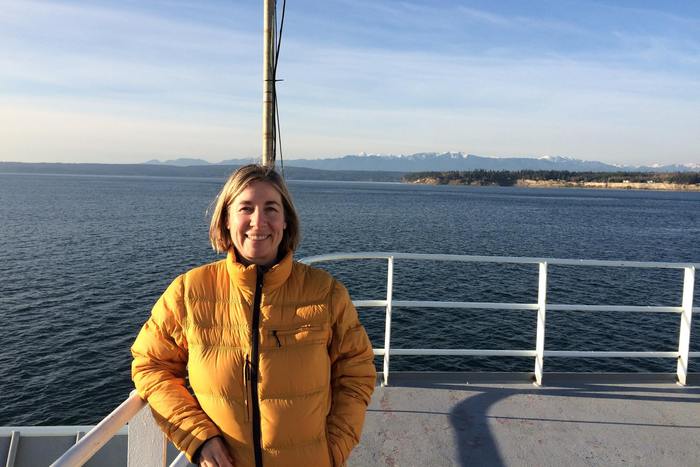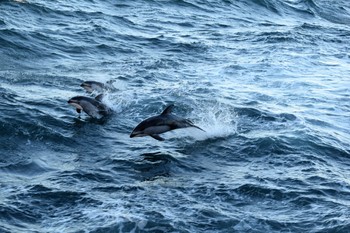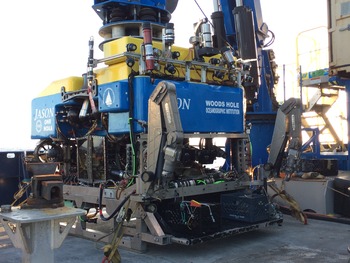I looked into the water from the fantail and saw two sharks!
Aug 25, 2017
Endurance Offshore Deep Profiler. Crews deployed the profiler this morning, and at dinnertime, Jason plugged it in, folks onshore enabled it, and tested it with a successful ascent. This year’s new plug mechanism drew praise for the way four appendages popped-out of the plug once it was seated.
Sharks, Whales, Dolphins. During this morning’s profiler deployment, I looked into the water from the fantail and saw two sharks! They were nearly 5’ long, with lean dark brown bodies and black markings. Possibly leopard sharks? At dusk, we were treated to a few whales (Minkes?) off the starboard side of the vessel. At the same time, dozens of dolphins were zipping-around the bow of the ship, sometimes with 4-5 riding the bow-wave at the same time and simultaneously going airborne. It seemed that the larger the waves, the more exuberant were the dolphins.
DVM Video Filming. Aaron and I re-worked our video script today to accommodate a change in available data by interviewing Skip about whether a fisheries echosounder (one is sitting on the deck currently) could read the movement of zooplankton during an eclipse, by referring to other scientists’ efforts since the 1950s to conclude that DVM indeed happens during the fall of darkness during a solar eclipse, (yes, it does)! I think our re-worked video will be interesting and educational for all audiences, and a review of available You-Tube videos on this topic suggests there is room in the You-Tube marketplace for the DVM video we have designed.
Aug 24, 2017
Endurance Offshore Deep Profiler Recovery. The APL crew worked all morning recovering the Endurance Offshore Deep Profiler. Due to the heavy weight of the load, the crew employed Yale grip technology to spread the weight. It was a methodical, tedious process that took several hours. Around lunchtime, they got enough wraps around the spool to begin pulling the profiler array upwards continuously. I was given the task of looking over the stern of the vessel and notifying the crew when I spotted the emergence of the profiler from the depths. Tomorrow, the APL crew will deploy a new deep profiler at the same location, so preparations for the new deployment happened into the evening.
Jason Dive Aborted. During my watch at 1600, Jason was launched to perform the mission of changing-out the sonar equipment at the Endurance Station. Visibility upon descent was poor, with significant volumes of marine snow, cnidaria, and suspended sediment. Eventually, Co-Chief Scientist and Chief Engineer Skip Denny was summoned the control van, and the decision was made to abort the dive. Skip explained this was the poorest visibility at this location in four years. We speculated on reasons for the poor visibility: Large tidal swings post-eclipse, sediment suspended from ongoing dredging operations in Newport, normal ocean circulation, and high volumes of zooplankton.
DVM Video Script Synched and Filming Begins. Aaron and I independently wrote scripts for our major project—videos discussing Diel Vertical Migration. Fortunately, our scripts meshed well—Aaron’s introductions were outstanding, and we will use the body and conclusion from my script. We designed, assembled, and prepared props and did a test film of the video designed for children and young students. Later, we will take a more academic approach to the topic in a video designed for adult students.
Zooplankton Net Tow. After dinner, a group of students assisted Wu-Jung in the three-tier zooplankton net tow. I helped by adding weights to the bottom of the mechanism, hooking-up the net with the carabiners we placed yesterday, labelling collection buckets, and assisting in the recording of events. As stiff wind is blowing, and since skies are clear, the temperature is dropping quickly this evening. The Oregon Coast is visible from the Endurance Offshore station.
Aug 23, 2017
Steaming from Axial Summit to Slope Base. Our most quiet day so far. I began the day rinsing and re-assembling the RAS/PPS collection receptacles we processed yesterday. It was a methodical process, with the replacement of missing O-rings being the most creative element of the task. I also joined in the work of attaching carabiners to zooplankton collection nets for Wu-Jung of APL. I also spent some time on the bridge. I learned that Rod, the 2nd mate and I had both previously worked in the international containerized shipping industry in the early 1990’s. I also talked with the 3rd mate, Todd, about working with the millennial generation. Visibility is about 1 km due to fog, and we are steaming in following seas. I use the term, “steaming,” which refers to an older style of powering vessels that involves the burning of bunker fuel, with steam powering the engines. The Revelle uses diesel/electric and yet we don’t say that we’re “dieseling” to Slope Base. I had an interesting conversation with Lisa of Woods Hole. She is an engineer on the Jason team. I learned that she replaced another engineer, Loral, who recently was selected as one of 12 new astronaut candidates for NASA. It’s fun to meet and get to know a variety of interesting people. Also today, I exchanged emails with Deb, and decided on my cruise projects.
Aug 22, 2017
Jason performing maintenance. Jason remains busy performing maintenance of Axial stations. Late last night, technicians deployed the “undervator” to deliver and carry-up equipment and gear. The undervator looks like a bright green crib. While most of ate breakfast this morning, Jason repositioned a tripod at “Tiny Towers” to improve light projection and to get a better camera angle.
Deep Profiler Mooring Deployment. Today, the APL crew worked all day and into the night deploying the Deep Profiler Mooring at the Axial Base. The mooring contains a vertical array of instruments designed to explore chemical, biological, physical properties of a part of the ocean at the base of the Axial Seamount. In this location, the older oceanic crust is estimated to be approximately 1 million years old, which in geological terms is relatively new, given that the ocean crust in nearby regions has an average age of 9 million years. Also at the base is younger, more buoyant material that floats above a magma chamber. During a subduction zone earthquake, the older, denser ocean crust would subduct under the younger, less dense material. While this location is less likely to subduct than other zones based on the relative geological youth of its ocean crust, it is within 200 kms of more likely subduction zones. This mooring helps promote the progress of science in this region by increasing our understanding early-warning signs associated with the base region of the seamount. Subduction of an oceanic plate potentially affects populations of millions of people, as well as Pacific Northwest infrastructure that is vital to the region’s economic well-being.
At the top of the Deep Profiler Mooring array is a large float—very large boulder size in sediment-speak—that contains the same syntactic float technology as the 34 syntactic floats regularly used on the Jason cable—thousands of tiny glass spheres surrounded by epoxy. The float provides nearly 1000 kg of buoyancy, and deploys at 80 meters depth. Its purpose is to maintain tension along the line all the way to the 2120 kg cast iron anchor at the seafloor (2600 meters deep). Tim from APL gave me a tour of the major components of the Deep Profiler Mooring. The deep profiler vehicle the moves vertically along the cable is the actual data-collection machine, and serves as a platform containing various sensors: A CTD, an acoustic current meter (uses sonar technology), an oxygen sensor, and two fluorometers. One fluorometer measures chlorophyll and the other CDOM (color dissolved organic material, which I understand, essentially, to mean dead phytoplankton and fish poop). The CDOM also will measure backscatter. To communicate findings, the vehicle contains a wi-fi antenna and an ICC (inductive communications coupling) that provides continuous communications. To power the operation, the profiler vehicle magnetically links with the electronics sensor housing, which plugs into the OOI (Ocean Observatory Initiative) cable array that reaches to its 10,000 Volt power station in Pacific City, OR. Power is transformed to 375 Volts, and stored in batteries encased in glass spheres located within the bright-yellow NSF-labeled, vehicle housing. Exposed materials used are titanium, nylon and rigid plastics. The acoustic release assembly is located approximately 3 meters above the anchor. The acoustic release assembly is located approximately 3 meters above the anchor, and includes codes for interrogation, reply, enable, disable, and release. Prior to deployment, Chris from APL tested these codes. The system uses two frequencies, and the various codes distinguish each command. The logistics of getting this whole operation to the ship are remarkable—for example, the spool assembly arrived over the road on a low-boy from Pennsylvania and required an onshore crane to lift it onto the Revelle. The APL crew spooled the cable using 2000 lbs of pressure. Even more daunting is the coordination required of the Principal Investigators, over a period of many years, to bring together the various scientific disciplines, funding, and operations to ensure the entire deployment, communication, and recovery processes take place and that meaningful data is derived, analyzed, and used for future scientific progress. I feel a great sense of pride to be living in a country that has the intellectual power, logistical capacity, and long-term vision to explore the depths of our oceans.
Hydrothermal Vent Fluid. Also today, the APL crew lifted fluid samples that have been collected from hydrothermal vents located in the “International District” over the past year. I was part of a team of six who processed these samples. Predictably, the samples emitted strong smells of sulfur and other chemicals. Many of the samples contained fizzy fluid, and some were difficult to open based on the gassy-pressure emitted by the fluid, sending-off a popping sound like opening a shaken pop bottle. I was glad to be doing this work outdoors in easy seas. The smaller of the sampling containers contained a filter and fluid that contain DNA from bacteria and microbes. With that said, byproducts of the collection process suggested that temperatures at these vents were as high as 130 degrees Celsius, which is too high for organisms to survive. Typically, life at the vents is more prolific at around 20 degrees C. After dinner, I gathered a handful of students to assist Mitchell at APL in pushing water through RAS filters and storing the rinsed filters in petri dishes for later analysis by NOAA scientists. The total processing of these fluids, done in teams of five or six at a time, took five hours. The collection and analysis of fluids and DNA at hydrothermal vents advances science and the information acquired will be used in a variety of disciplines to aid understanding of the composition of fluid and life at hydrothermal vents.
Aug 21, 2017
Solar Eclipse. The ship was scheduled to transit within the 70-mile-wide path of totality on its way to the Axial Seamount. The morning was foggy, with some local sunny patches. At 0830, a problem with the starboard bow thruster caused a delay of about 45 minutes, which was promising, because at that time, the skies were relatively clear. Alas, the problem was fixed, and we cruised directly into the fog. A group of crew and science party converged on the fantail around 0940 and joked-around that we would be seeing “a total eclipse of the fog.” An APL employee accurately remarked, “I don’t even know where the sun is!” A scientist suggested a blank photo accompanied by #NSF. In fact, we could see nothing. A crew member played tunes from Pink Floyd’s “Dark Side of the Moon” album. As the sky began to transition from grey to darker grey, we reached the dewpoint, and water dripped from the skies. Then it was dark. Slowly it became light again, and most people returned inside the ship. Then, the fog sporadically thinned, and the few of us remaining got fleeting views of the eclipse. We couldn’t see the eclipse through our eclipse viewing glasses, because it was veiled by the fog. We hoped we weren’t burning our retinas by catching views of the sliver of bright white sun through the fog with our bare eyes. Time passed, the fog continued to thin, and the progressing eclipse became fully viewable through the viewing glasses. When viewed through the glasses, the sun appeared the same blood-orange color we had anticipated.
First launch of JASON on Leg 3. Prior to the launch, technicians attached 34 “syntactic floats” onto the cable. The floats are made of thousands of tiny (~1 mm), lemon-shaped glass beads encased in epoxy. The floats help to neutralize the weight of the cable, dissipate the strain of the ships heave, and allow Jason to be “free-flying” or to move independently at the seafloor. I worked in the control van for this first launch, and recorded events. The purpose of this launch was to adjust the position of the HD Camera at “Mushroom Vent” in the “Ashes Field.” A conservative adjustment was made, the cable lines re-arranged along the array using the starboard manipulator, and launch was successful. At one point during the ascent, a red-armed octopus explored a corner of Jason. One of the scientists observed that the tallest vent on Mushroom had become taller since the last dive. We speculated that the active vents grow upwards, become unstable, and then collapse again.
Aug 20, 2017
Departure. After breakfast, a few volunteer scientists (two undergrads, a post-bacc, and a post-doc) walked to view the whale skull at the Hatfield Science Center, and discussed the evolution that allowed for the whale to keep its head down longer in the water, while still able to breathe. We could see two nostrils leading to one blow-hole. We also discussed the possibility doing a major project on whether zooplankton perform diel vertical migration during a solar eclipse, using acoustic measures as our method for collecting this data. Next, we walked through the park and waded in the ocean. I went for a brief dip. Fantastic. We re-boarded the ship at 1030 and sailed at 1300. While Newport was calm on this morning, the ocean was comparatively windy and rough. Our first station is located approximately 250 nautical miles away at the Axial Seamount.
August 19th
Arrival in Newport. Arrived at the Roger Revelle and was pleased to see Deb Kelley and to say hello to classmates who were departing Leg 2 of Visions ’17. It is a small world, and I learned that a friend from Seattle is a colleague of an educator/administrator from UW Tacoma who had sailed on leg 2. That afternoon, I walked in windy weather across the Yaquina Bridge to Nye Beach in Newport. After dinner, I walked the Estuary trail at Hatfield.




